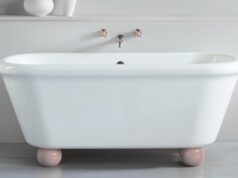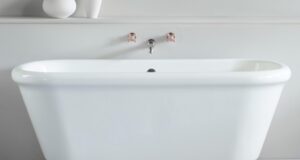
We all know what a bathtub is, but you might not realise how many different types and styles there are to choose from. Find out more about bathtubs.
There’s evidence that baths have been around for a very long time. Remains of copper water pipes found in the Indus Valley date back to at least 3300BC. The Romans did much to promote sanitation and made bathing a common practice, but it lost favour after the Renaissance when people believed that water could pass disease through the skin. Bathing then disappeared from Western culture until its revival towards the end of the 19th century, when baths were reintroduced. The idea of a dedicated bathroom in every home didn’t catch on until after World War 1.
Today there are as many styles of baths as there are bathrooms. Baths can be made of many different materials, and this allows designers to push the boundaries of what a ‘bath’ actually is.

Different types of baths
There are many different types of bathtubs. Some are designed for comfort, some for convenience and some for aesthetics. Some of the more popular types include:
- Clawfoot and pedestal baths
- Recessed or alcove baths
- Drop-in baths
- Free standing baths
- Corner baths
- Whirlpool baths or Jacuzzis
- Walk-in or gated baths
Clawfoot baths and pedestal baths
Clawfoot baths, as the name suggests, are baths that sit on four clawed feet. This style of bath came into popularity as a high society item during the late 19th century. As the bath was made of cast iron with a porcelain lining and was extremely heavy, they needed to reinforce the floor underneath to prevent them from crashing straight through. Newer materials allow them to be produced more cheaply and easily, and the originals are now collectors’ items.
There are several variations of clawfoot baths, including slipper tubs, which feature a high, sloped end to allow for greater comfort, and double ended tubs which are sloped at both ends (one end is traditionally ‘flat’ in conventional tubs). Another variation on the clawfoot tub is the pedestal tub, which sits on a pedestal rather than on clawed feet. Evidence of this style dates back to the Isle of Crete in 1000BC.
Recessed or alcove baths
Recessed or alcove baths are the kind of tub the majority of us are most familiar with. Usually installed against a wall on two or three sides, this type of bath is the most common variety and is found in the vast majority of Australian households. Its design hasn’t changed a great deal over the years, though the materials it is constructed of have changed from enamel coated steel or cast iron to acrylic or fibreglass. These baths are often found with showers over them.
Drop-in baths
A drop-in bath is one that’s designed to either drop into a cavity in the floor or a raised platform for a (more or less) flush finish. These types of baths can be quite aesthetically appealing but depending on how they’re designed, they can also be tricky to get out of. Another type of drop-in bath is the ‘overflow tub’, which is similar to an infinity pool in that it is designed to be completely filled to the brim. This type of tub is designed to overflow into a guttering system, which then circulates water back into the tub to create a striking visual effect.
Freestanding baths
Freestanding baths, in the simplest sense, are those that don’t connect to any walls for support. This is where some of the most innovative ideas in bathtub design have been allowed to grow in recent years, resulting in the use of a variety of unconventional shapes, materials and themes. Clawfoot baths and pedestal baths are technically ‘freestanding baths’, but the category itself also includes many other varieties.
Corner baths
Corner baths are triangular in shape and are designed to fit into a corner like a wedge. These sorts of tubs may be a good solution when space is limited and a regularly shaped tub isn’t practical. Corner tubs are often enhanced with air jets, turning them into whirlpool baths.
Whirlpool baths / jacuzzis
Whirlpool baths and Jacuzzis are a relatively recent development, making their first official appearance in 1968. Though it’s now an accepted generic term for whirlpool baths, ‘Jacuzzi’ is actually a brand name, and the surname of the man who invented it (Candido Jacuzzi, pronounced “Yah-KOOT-see”). In a whirlpool bath, openings located in the bath walls stream air bubbles and/or water jets, creating a pleasant sensation for the bather. They can be enjoyed with hot or cold water, and it’s claimed that they offer health benefits like improved circulation. Other variations on the same theme include include hot tubs and spas.
Walk-in / gated baths
Walk-in and gated baths feature high walls and a seat in the tub, with a door that opens up from one side to allow the bather to walk directly in without having to step over the wall of the tub. These tubs are typically used to help the disabled and elderly to bathe freely with minimal assistance. The bath itself has high walls and a seat inside. The design typically allows the bather to enter, sit upright without having to lower themselves in, close the door and fill the tub to the desired height.





